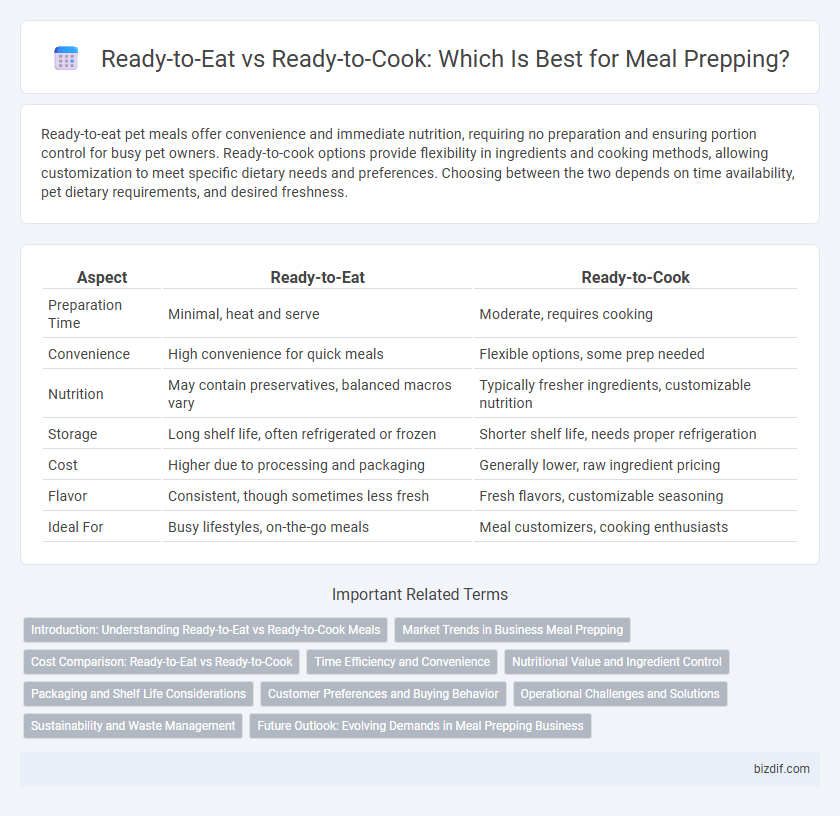Ready-to-eat pet meals offer convenience and immediate nutrition, requiring no preparation and ensuring portion control for busy pet owners. Ready-to-cook options provide flexibility in ingredients and cooking methods, allowing customization to meet specific dietary needs and preferences. Choosing between the two depends on time availability, pet dietary requirements, and desired freshness.
Table of Comparison
| Aspect | Ready-to-Eat | Ready-to-Cook |
|---|---|---|
| Preparation Time | Minimal, heat and serve | Moderate, requires cooking |
| Convenience | High convenience for quick meals | Flexible options, some prep needed |
| Nutrition | May contain preservatives, balanced macros vary | Typically fresher ingredients, customizable nutrition |
| Storage | Long shelf life, often refrigerated or frozen | Shorter shelf life, needs proper refrigeration |
| Cost | Higher due to processing and packaging | Generally lower, raw ingredient pricing |
| Flavor | Consistent, though sometimes less fresh | Fresh flavors, customizable seasoning |
| Ideal For | Busy lifestyles, on-the-go meals | Meal customizers, cooking enthusiasts |
Introduction: Understanding Ready-to-Eat vs Ready-to-Cook Meals
Ready-to-eat meals offer convenience by requiring no cooking, ideal for quick consumption and busy lifestyles. Ready-to-cook meals provide pre-portioned ingredients with minimal preparation, preserving freshness and allowing customization. Understanding the differences helps optimize meal prepping for time, nutrition, and taste preferences.
Market Trends in Business Meal Prepping
The business meal prepping market shows a significant shift towards ready-to-eat options, driven by consumer demand for convenience and time-saving solutions. Ready-to-cook products maintain steady growth due to health-conscious buyers seeking fresh ingredients with minimal preparation. Market projections indicate a CAGR of 8.5% for ready-to-eat meals through 2028, highlighting evolving preferences in urban and millennial demographics.
Cost Comparison: Ready-to-Eat vs Ready-to-Cook
Ready-to-cook meal kits generally offer a more cost-effective option compared to ready-to-eat meals due to lower processing and packaging expenses. Bulk purchasing of ingredients for ready-to-cook options further reduces overall meal costs, making them ideal for budget-conscious individuals. While ready-to-eat meals provide convenience, their higher price per serving often outweighs the financial benefits of cooking from scratch.
Time Efficiency and Convenience
Ready-to-eat meals significantly reduce preparation time by eliminating cooking and allowing immediate consumption, ideal for busy schedules and on-the-go lifestyles. Ready-to-cook options offer flexibility in ingredient customization but require additional time for cooking and cleanup, impacting overall convenience. Choosing between ready-to-eat and ready-to-cook depends on prioritizing time efficiency or culinary involvement in meal prepping routines.
Nutritional Value and Ingredient Control
Ready-to-eat meals offer convenience but often contain higher levels of preservatives, sodium, and added sugars, which can diminish overall nutritional value. Ready-to-cook options provide greater control over ingredient quality and portion sizes, allowing for fresher, nutrient-dense meals tailored to dietary preferences. Selecting ready-to-cook ingredients enables customization for balanced macros and reduced artificial additives, supporting healthier meal prepping outcomes.
Packaging and Shelf Life Considerations
Ready-to-eat meals typically feature packaging designed for immediate consumption, often vacuum-sealed or sealed in microwave-safe containers to maintain freshness and convenience. Ready-to-cook meals use packaging that preserves raw ingredients, such as modified atmosphere packaging or freezer-safe bags, optimizing shelf life. Shelf life for ready-to-eat options is generally shorter due to minimal preservation methods, whereas ready-to-cook products benefit from freezing or refrigeration techniques that extend usability.
Customer Preferences and Buying Behavior
Customers show a growing preference for ready-to-eat meals due to their convenience and time-saving benefits, especially among busy professionals and urban dwellers. Ready-to-cook options appeal to health-conscious consumers who prioritize freshness and control over ingredients while seeking efficiency in meal preparation. Market trends indicate increased purchase frequency of ready-to-eat products in on-the-go segments, whereas ready-to-cook items dominate among families aiming for nutritious homemade meals.
Operational Challenges and Solutions
Ready-to-eat meal prepping simplifies daily food consumption but faces operational challenges such as shorter shelf life and higher packaging costs. Ready-to-cook options extend product freshness and reduce waste but require efficient inventory management and consumer education for proper preparation. Implementing temperature-controlled storage systems and interactive cooking guides enhances operational efficiency and customer satisfaction in both models.
Sustainability and Waste Management
Ready-to-eat meals reduce food waste by minimizing leftovers and excess portions, while ready-to-cook options often use less packaging and fresher ingredients, supporting sustainability. Choosing sustainable packaging materials in both meal types further decreases environmental impact and improves waste management. Efficient meal planning with either ready-to-eat or ready-to-cook meals enhances resource use, reducing food spoilage and landfill contributions.
Future Outlook: Evolving Demands in Meal Prepping Business
The meal prepping business is witnessing a shift as consumer preferences lean towards both ready-to-eat and ready-to-cook options, driven by convenience and health consciousness. Innovations in packaging and preservation technology are enhancing the shelf life and nutritional value of ready-to-eat meals, while ready-to-cook kits gain popularity due to customization and freshness appeal. Market forecasts predict significant growth in hybrid meal solutions that combine the ease of ready-to-eat with the quality and involvement of ready-to-cook, catering to evolving lifestyle demands.
Ready-to-eat vs Ready-to-cook Infographic

 bizdif.com
bizdif.com